Vivariums are a true naturalistic slice of life.
Yours to cultivate for your own enjoyment and that of your tropical animals. But in the wise words of Uncle Ben, “With great plants and animals comes great responsibility.”
Honestly, a vivarium setup can be a lot more complex than your average tabletop terrarium, and there’s more at stake than the lives of some mossy clumps and the odd fern.
So, in this guide, I’m going to provide a complete overview of the vivarium hobby.
Walking you through every element of design/construction, plants, inhabitants, and care – to make sure you end up with a thriving vivarium ecosystem at the end of it.
Ready to build a natural habitat you’d be proud to call home?
Let’s go.

Terrarium Tribe is reader-supported. When you purchase through links on our site, we may earn an affiliate commission (at no further cost to you). 💜
A Quick Primer on Vivariums (+ Types of Vivarium)
Over time, the word vivarium has come to mean a great variety of things.
It’s a bit of an ambiguous term these days, but at least the meanings share one singular theme. Looking at the root of its language, we can see a hint as to what that theme is.
In Latin, vivere means “to live,” and arium means “place” or “container.”
So, in a sense, a vivarium is simply a “place of life.”
In context, a vivarium is a container that’s designed and optimized to cultivate a particular type of life/environment. This is true of all the “ariums” and their various inhabitants (e.g., aquariums).
In this case, the word is used to describe two main types of vivariums:
- Arid vivariums – These are commonly paired with desert-dwelling lizards or snakes along with arid plants like succulents.
- Tropical vivariums – The kind we’ll be primarily discussing here, optimized for moisture-loving plants and tropical species of reptiles and amphibians.
So, this article is for all you budding horticulturists and herpetoculturists!
Vivarium Ecosystems – Systems & Factors
Cultivating plants and animals together makes for more complex ecosystems.
In practice, it’s the next level of terrarium building.
They often require a different, more direct approach to management. Where simple plant terrarium ecosystems can be observed and gently tweaked, environmental conditions in vivariums typically need to be monitored and tightly controlled.
So, the tools and setups tend to become much more sophisticated.
Sometimes with artificial systems (e.g., artificial lighting), sometimes with good design (e.g., built-in ventilation), and always with a bit of luck.
Next, we’ll take a high-level view of all of the important factors involved in vivarium ecosystems.
Airflow / Ventilation
Unlike your typical sealed terrarium, vivariums need some level of consistent airflow and gas exchange.
Animals need to breathe, remember?
Plus, airflow helps your plants to dry off after watering and prevents mold formation (particularly in tropical setups).
So, you’re going to need a suitable ventilation solution.
Thankfully, it doesn’t have to be super technical; a simple hole/gap in the lid or some drilled holes in the container can be enough to do the trick. You can always cover it with a mesh to prevent escapees!
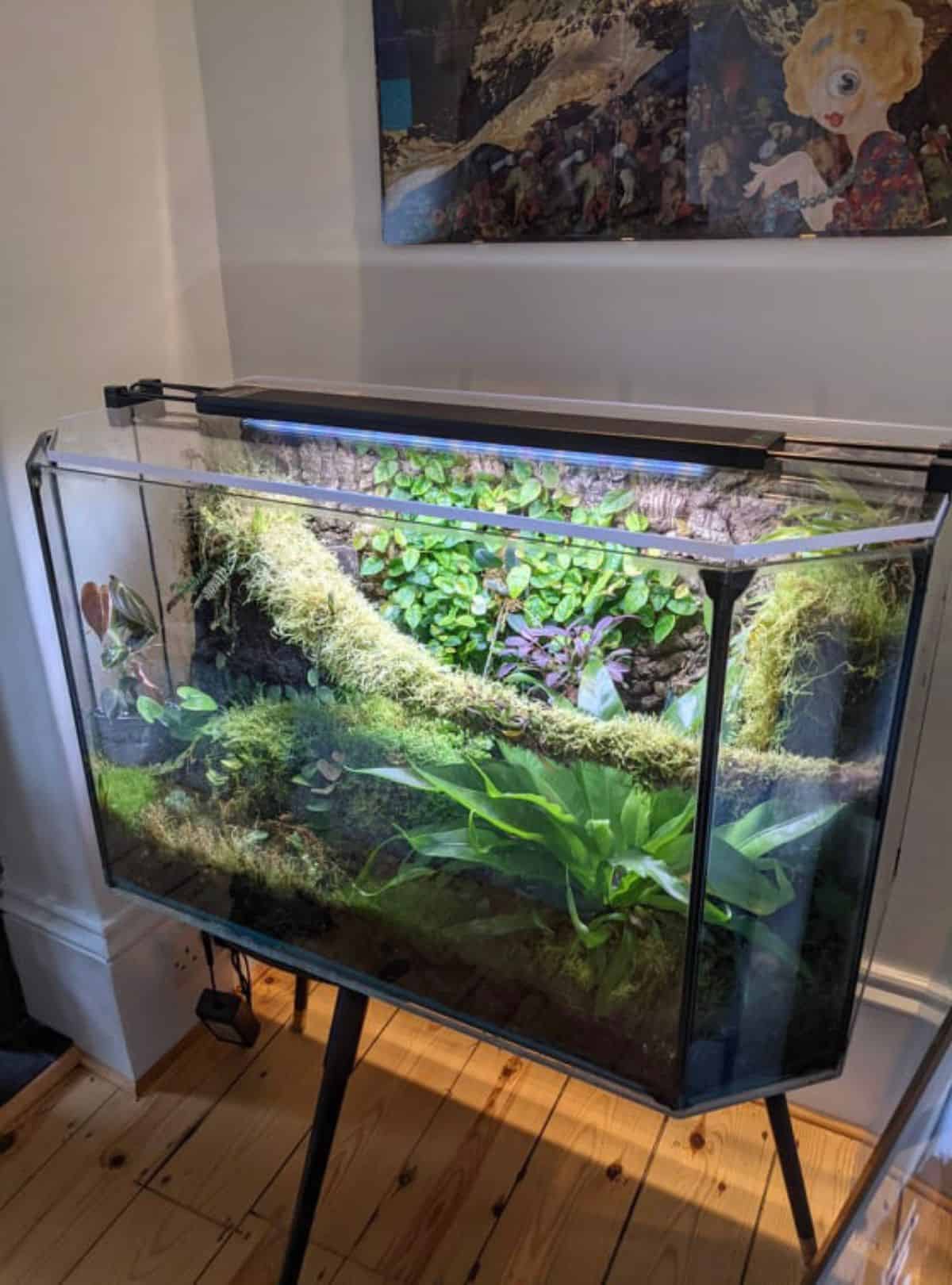
Some people like to use small fans to take more control of the system, but that’s up to you.
Water & Humidity
Tropical vivariums are going to need consistent high humidity.
How much will depend on the plant and animal species, but it’s likely to be upwards of 70%.
In a simple plant terrarium, high relative humidity is usually achieved with a complete seal on the container. But if you’re keeping animals, then an airtight seal is not such a good idea…
So without a full seal, you’ll get some moisture loss, so you’ll need a system to replace it.
These come in the form of misting systems.
Essentially a system of pumps and nozzles which can be programmed to periodically spray your vivarium down with a light mist/fog – giving a nice even watering and boost in humidity.
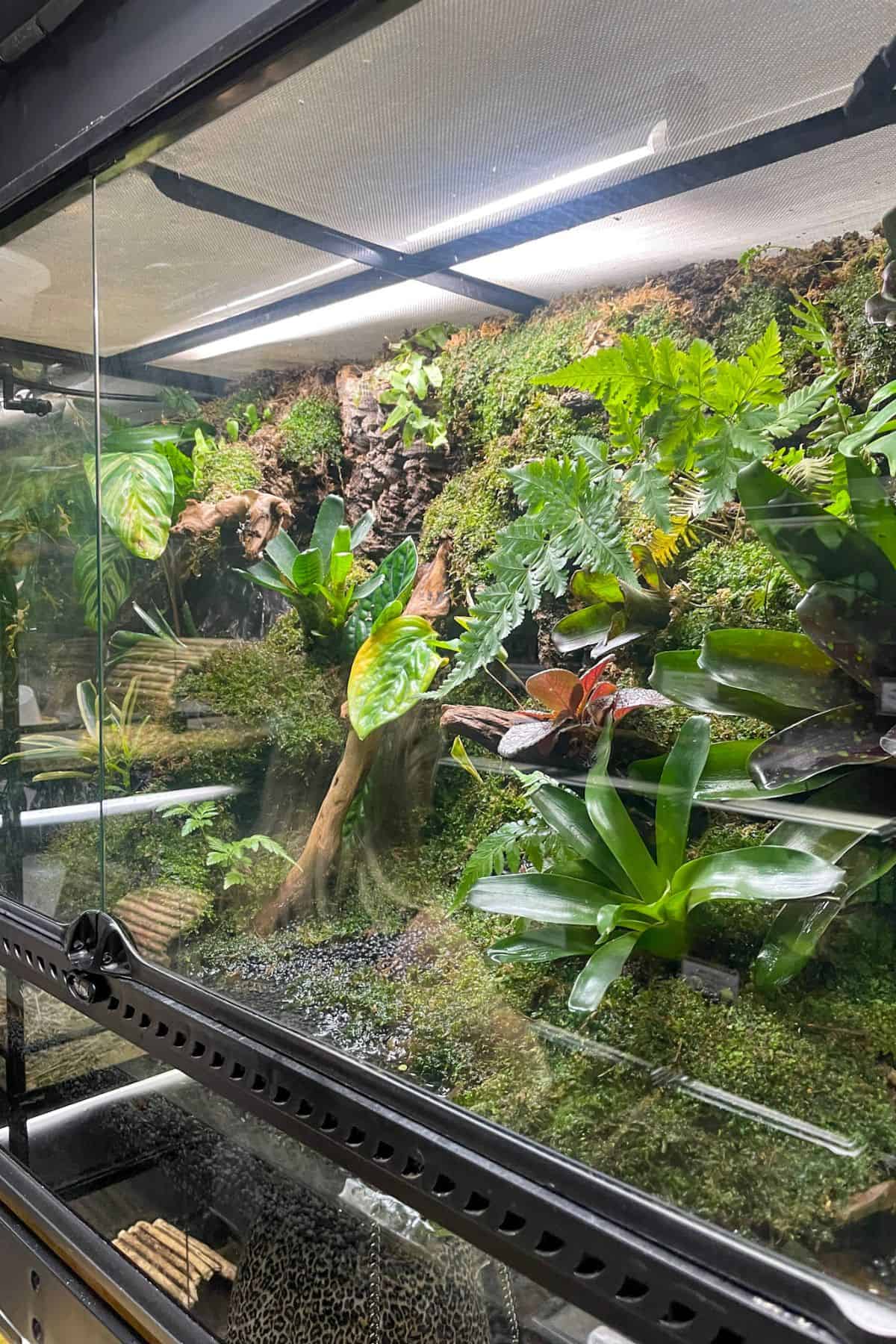
Naturally, arid terrariums can manage without these.
Lighting
Nailing the lighting conditions is often enough of a challenge for simple planted terrariums.
As you might imagine, it’s a whole lot harder in a large container… a container that’s sometimes opaque on several sides.
So, grow lights are pretty much essential here.
If you’re keeping animals, you’re going to need to research their specific needs and build your lighting kit accordingly. Truth be told, it can get fairly complex if you’re using the light to mimic day/night cycles, but if it’s mostly for plants, then it’s a lot more straightforward.
They tend to come in the form of LED strip lights that you can fit to the top of the container to apply the most balanced spread of light.
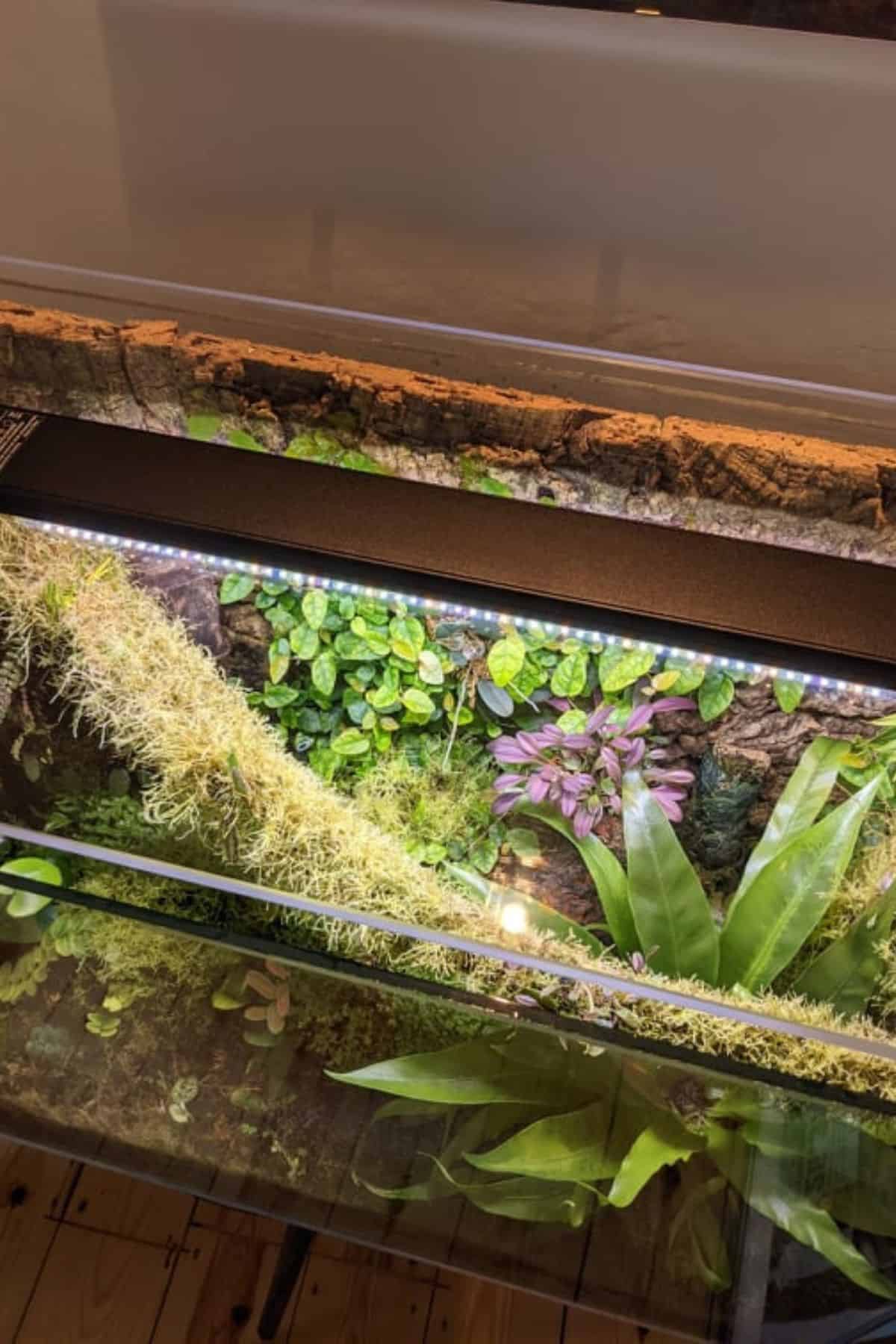
A strip light like this one is probably best for beginners, but this rabbit hole runs deep for those really looking to optimize plant growth and/or animal care conditions.
Temperature
When you’re growing tropical plants, you’re going to need tropical temperatures.
There’s always a little wiggle room, but it’s probably going to be in the range of 21-30 °C ( 70-85 °F).
However, this gets a lot trickier when you’re raising animals, particularly of the cold-blooded variety. If you’re keeping some reptilian or amphibian friends, you’ll need to control the ambient temperature more carefully.
Heating mats and heating lights can both be effective, depending on the species.
A thermometer is pretty important, too, if you’re trying to operate within a range.
Regulation (Putting it all Together)
For those who need to manage all these factors within a narrow range, it’s worth considering a system that can work together.
Many pieces of modern vivarium hardware can be fitted to a smart thermostat / universal controller.
For both peace of mind and ease of use, a fully controllable system really is the way to go.
Plus, the more advanced systems can more effectively recreate day/night cycles, weather patterns, and more – so your animals can feel right at home.
Microfauna / Bioactivity
One of the more complex (and rewarding) elements of vivarium building is mastering the art of bioactivity.
Harnessing the awesome power of microbes and beneficial little bugs/critters to regulate and clean your vivarium.
Just like Mother Nature herself!
There’s a wide range of container custodians available, but isopods and springtails tend to be the most popular and effective. They’ll eat any mold or decaying organic matter, keeping your vivarium healthy and fresh.
👉 Shop springtails and isopods for vivariums on our online store. (Look for the isopods with the purple “Cleanup Crew” badge!)
Be sure to give them plenty of leaf litter to feed on/hide in, too.
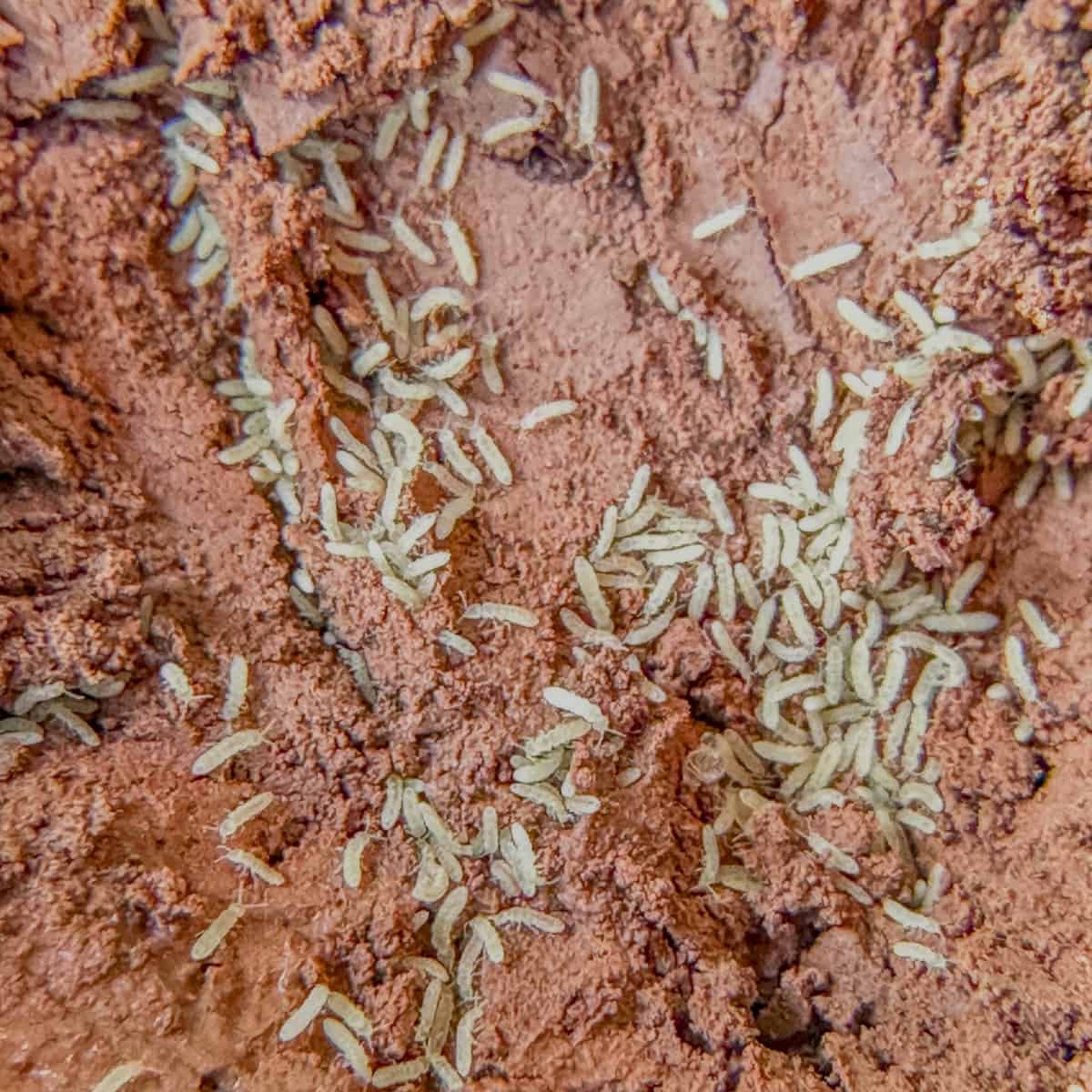
If you’re prepared to dive into some more complex science, you can also seed your bioactive substrate mix with all kinds of beneficial bacteria and fungi. These can help with nutrient recycling and distribution and generally just help form the base of the bioactive processes.
Read more: The Best (& Worst) Terrarium Insects and Bugs: 12+ Species and What is a Bioactive Terrarium? (+ How to Make One).
How to Make a Vivarium – DIY Guide
Container
Unlike your smaller terrariums that can be fashioned from all manner of glass containers (like vases, bottles, and boxes), vivariums tend to follow a much more structured pattern.
They’ll need plenty of volume to house any animals and any of the extra structured elements that might be needed to keep them, e.g., fans, heaters, etc.
Sure, the more DIY-centered people might like to upcycle an old glass cabinet or fish tank into a terrarium (I love seeing transformed Ikea cabinets on Instagram!), but realistically, most are going to buy a manufactured vivarium.
And there’s plenty to choose from.
You could opt for a tall cabinet-style arboreal vivarium to show off some larger epiphytes and climbing species. Or your classic wooden vivarium landscape-style tank to get a wide variety of terrestrial plants and hiding spots.
There really is something for every need.
Drainage
Where you can often manage without a drainage layer in small terrarium setups (provided you have the watering technique perfected), they become essential in larger tropical vivariums.
That’s because all that extra ventilation necessitates more regular watering – and that water needs to go somewhere. Otherwise, it’ll quickly waterlog the tank.
Drainage layers essentially act as a foundation and reservoir for your vivarium tank.
In some ways, they’re a fail-safe for overwatering, but they also carry additional benefits in boosting ambient humidity and supporting the reproduction of some of our micro custodians.
Leca is a common material choice for its ability to effectively hold both water and the weight of the plants and substrate whilst being pretty lightweight itself.
You can use gravel/stones, but it’s going to get heavy real fast.
Barrier
Now, before we move on to the substrate layer, we need to make sure it can’t fall into our freshly made foundation.
That’s why we put up some sort of mesh/fiber/screen barrier that still allows water through but won’t allow substrate particles to block up the drainage layer.
A fiberglass screen is a common and inexpensive barrier that won’t rust or break down.
👉 We sell squares of Terrarium Substrate Mesh cut to a variety of convenient sizes.

Substrate
The substrate layer is the growing medium that you’re going to be planting into.
It sounds simple, but it’s hard to understate just how important it is to get the right substrate mix here.
For starters, it needs to be able to:
- Retain moisture.
- Drain well.
- Resist compaction.
- Remain stable and resist breakdown.
- Provide nutrition.
A popular choice is the classic ABG mix. It ticks all the boxes in terms of function, but it does include some non-sustainable ingredients, so it isn’t the best choice environmentally.
Our own substrate mix takes inspiration from ABG; only ours is a peat-free variation. It has all the necessary components in a well-optimized ratio to provide the best possible blend.
👉 Check out our premium terrarium substrate on the Terrarium Tribe shop.
Then, in terms of adding and sculpting the substrate, you might want to slope it towards the back or in particular areas. That way, you can create a more dynamic landscape than just a flat surface.
Hardscape
Honestly, vivarium hardscape is the unsung hero of a scene.
Gnarling branches and textured rocks are what create structure and dynamic shapes. Not to mention lots of great 3D planting spots for epiphytic plants.
Online, there’s a huge variety of hardwoods and aquascaping rocks to choose from (Buceplant has an amazing range).
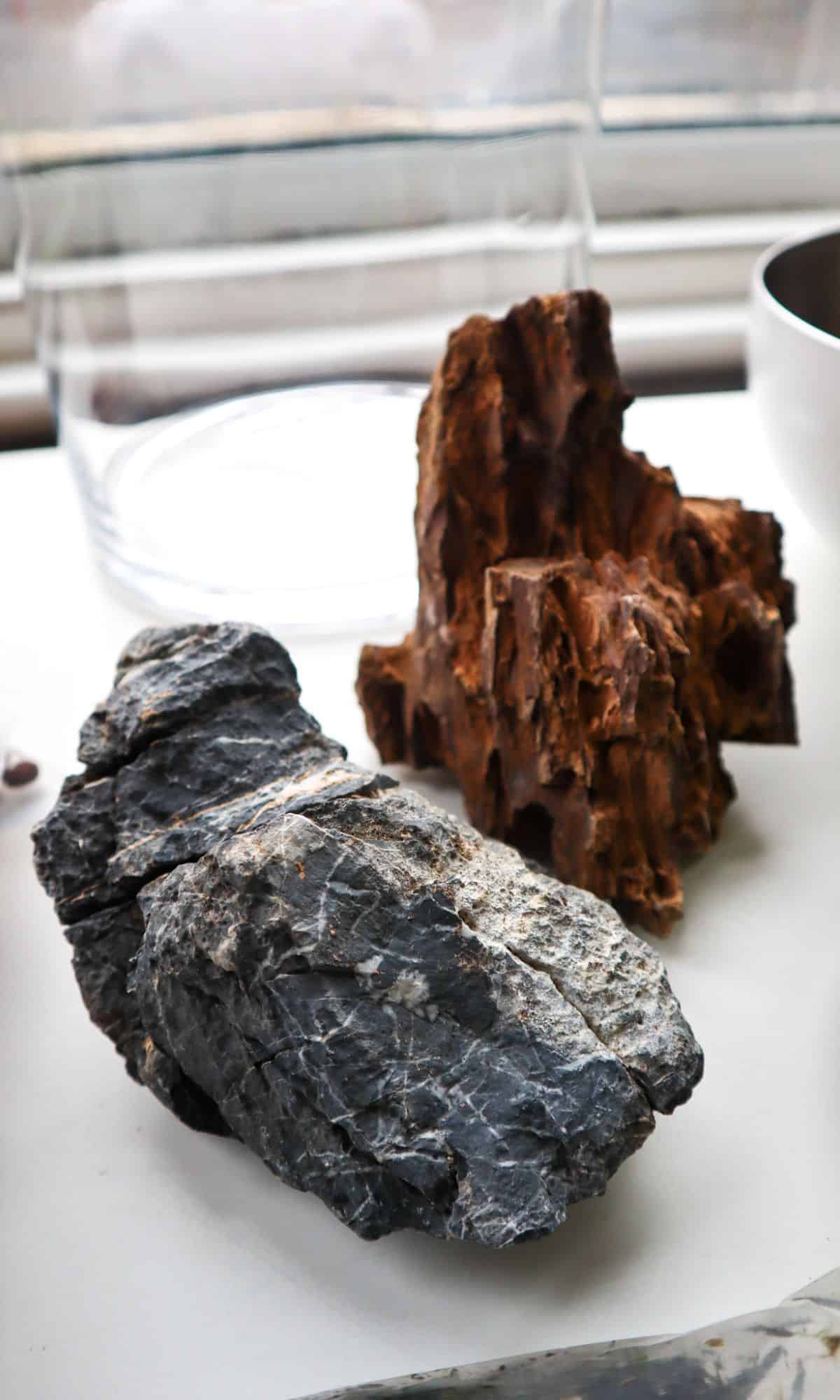
And don’t forget the back and sides of your container!
It’s common to add a premade or custom vivarium background (or make your own using foam and silicone if you’re DIY-inclined) in order to create some natural shapes.
Seriously, hardscape is an incredible tool for aesthetics, but it’s also important for your inhabitants. Whether it’s something to climb, hide under, or just generally make them feel more at home – try to choose accordingly with your species of choice.
Read more: 10 Dynamic Types of Wood for Terrariums (+ Photos) and 3 Visually Stunning Terrarium Rocks for Creative Planting.
Ground Cover
Ground cover is important for a true, naturalistic look, but it’s also an essential part of a bioactive vivarium.
When I say ground cover, I’m mostly talking about leaf litter and similar organic materials.
It’s going to cover any areas of the exposed substrate with natural-looking material, but most importantly, it will slowly break down over time – providing nutrients for the plants but also food for the various microfauna in the vivarium.
👉 Grab a bag of Organic Leaf Litter right here.
Vivarium Plants
Now, the exciting part!
Vivarium plants are as varied as they are beautiful. With all the extra controls a vivarium provides, it opens up a lot of new doors in terms of plant choice.
Not just in size (though in some cases, bigger is better) but also in diversity and type.
The real challenge – and fun – lies in using such vivarium space to its fullest extent. Really bringing that naturalistic environment to life with a variety of shapes, sizes, colors, and textures.
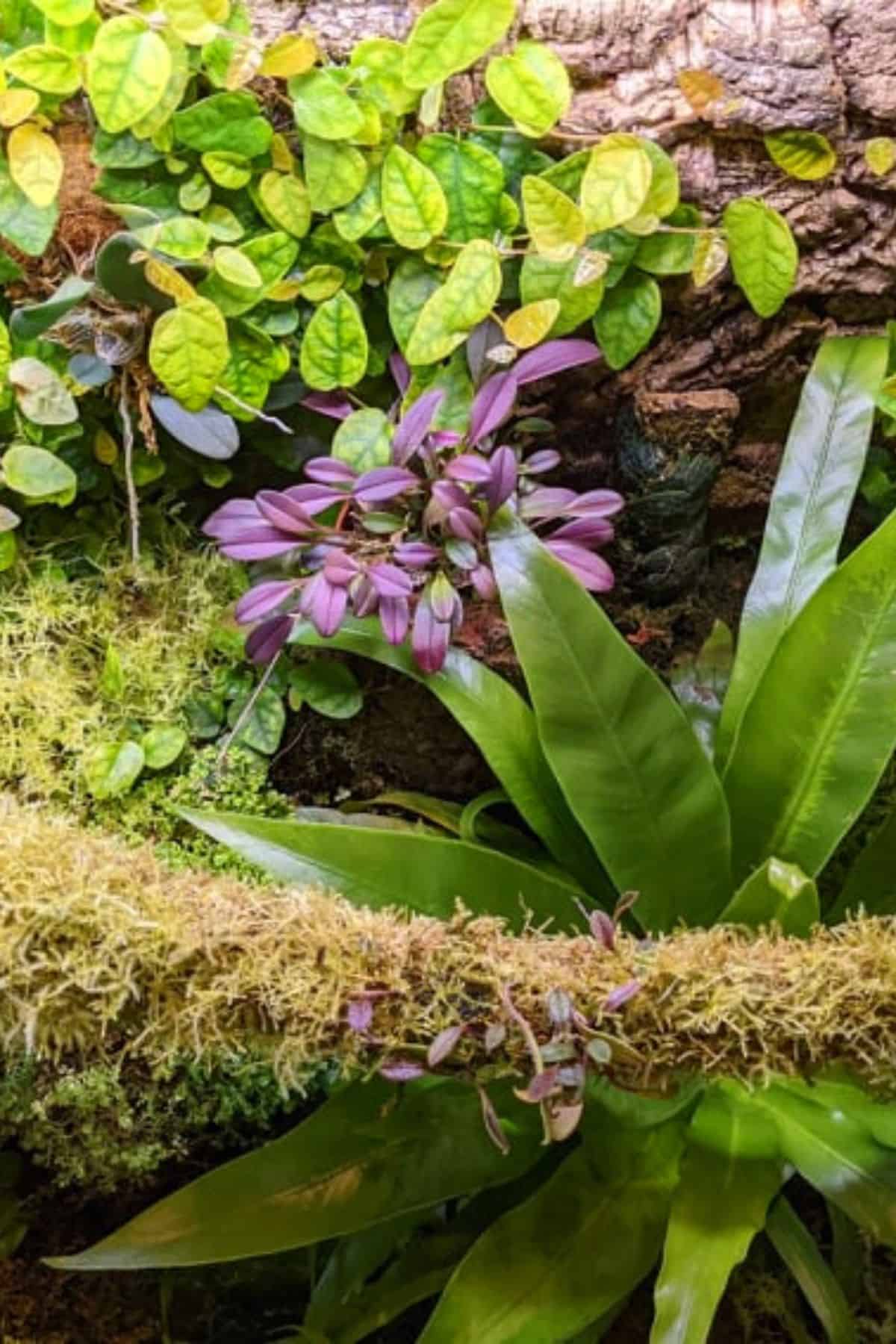
To achieve this, you’ll want a nice balance of:
- Ferns – These are full of texture, and they love the warmth and humidity of a tropical terrarium. A nice mix of broad-leafed and feathery ferns can really bring some dynamic foliage to a vivarium.
- Vines – Both big and small, vines are the wild element of growth that looks natural and can link areas of a vivarium together. Plus, as natural climbers, they’re a good way of adding some verticality to your foliage mix. For larger vivariums, you can even experiment with some of the larger and more exotic aroids.
- Foliage – The stars of the show. Foliage plants are simply those with eye-catching leaves, and they’re typically placed in the foreground of a vivarium as a focal point. You don’t need many of these, just a few to make the view pop!
- Moss – In my opinion, moss should be used liberally in a vivarium. It’s what ties everything together visually and really brings a space to life. A reliable tropical sheet moss (e.g., Thuidium delicatulum) can be trained to grow on top of both the substrate and the hardscape to achieve a natural lush effect.
- Epiphytes – These are plants that grow on other plants and objects. Which makes them perfect for 3-dimensional planting around the container. Without these, you’ll have all the fun stuff at the bottom and an empty tank everywhere else – so be sure to make use of them.
To create a true sense of scale, you’ll want to plant the largest species at the back and the smallest species near the front.
Read more: The 10 Best Terrarium Plants for Beginners (Easy Care Picks).
Vivarium Animals
With the loose definition of a vivarium being a container that’s designed and optimized to cultivate a particular type of life/environment – it follows that you should really stick to one.
In fact, the general rule of thumb in the industry is that you should build your vivarium around a single animal species.
Honestly, there’s just so much to consider in terms of optimizing an environment. Even just balancing a plant-only ecosystem has its challenges, and a habitat for a single animal can bring a whole new level of complexity… let alone multiple species.
Whichever species you choose, you must research their specific wants and needs.
But, I’m sure you know that! After all, designing an environment that’s a good fit for both you and your animals is half the fun.
Choosing a Vivarium Animal
When it comes to choosing a species for your rainforest terrarium, it’s best to consider what I call “The Three S’“
- Small – So they won’t trample your plants, and they’ll typically feel much more at home in average-sized containers. Here’s a list of great small vivarium animals.
- Stable – Species that don’t need crazy seasonal fluctuations or any extremes of temperature/humidity are going to be the easiest to keep.
- Sedentary – The more naturally sedentary a species is, the happier it’s going to be chilling in an enclosed environment (and probably more visibly too).
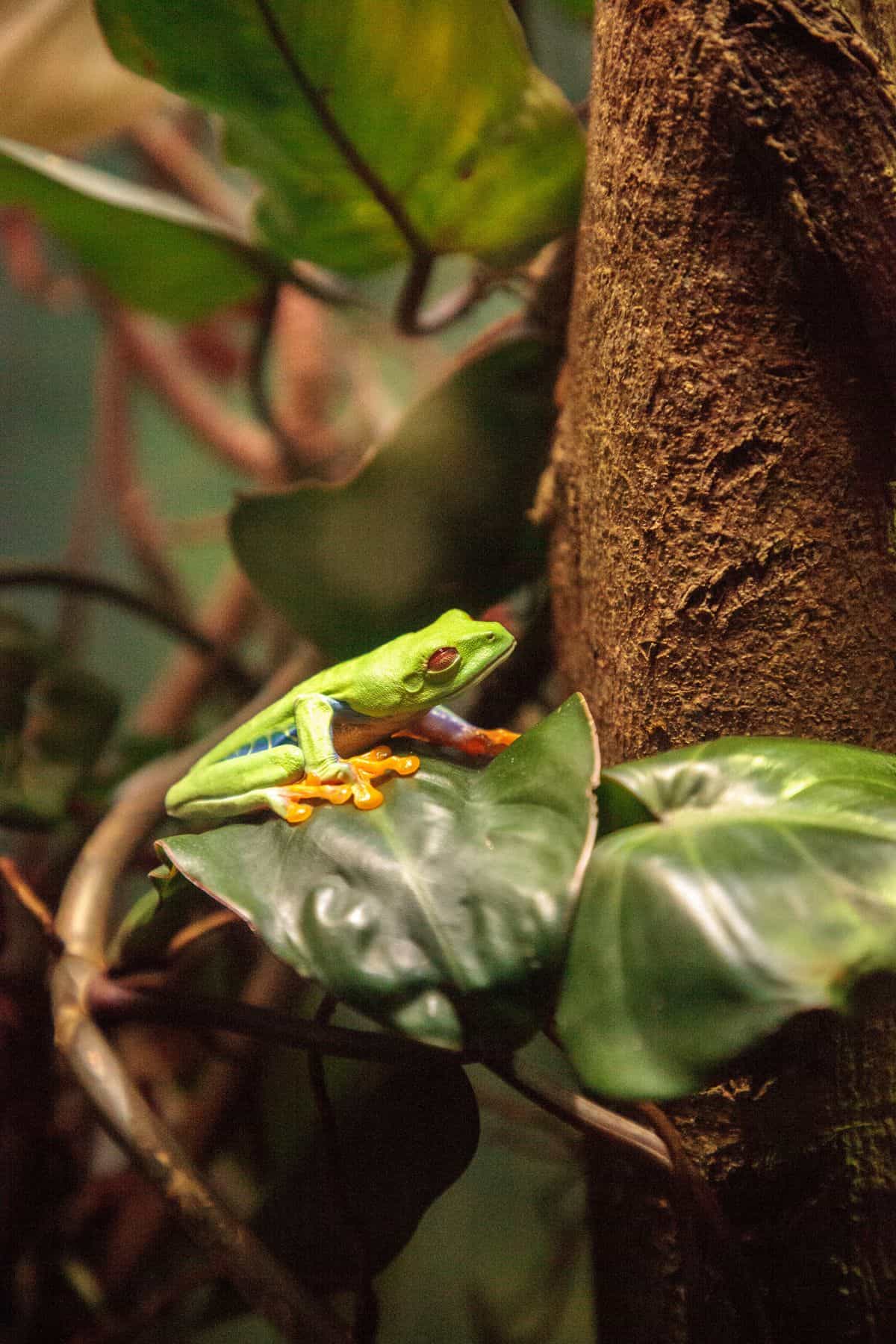
With that out the way, let’s consider the (many) great options for a tropical vivarium.
- Frogs – With all manner of tree frogs and poison dart frogs, there’s a huge variety of vibrant colorful species to choose from.
- Lizards – Arboreal lizards like geckos are excellent candidates for taller vivariums with plenty of branches to climb. Crested geckos are regarded as being great for beginners, but there are plenty of others to choose from. Check out my full guide to terrarium lizards for more inspiration!
- Snakes – In a similar vein, climbing snakes like tree boas and tree pythons are natural choices for vivariums. Their laidback temperament means they’re happy to hang out on your hardscape.
- Insects – For smaller vivariums, something like a mantis can be a really exciting addition. Check out these exotic pet terrarium insects and bugs.
Over to You
If you’ve made it this far, well done!
Hopefully, you have a good idea of what it takes to make and maintain a true vivarium.
That being said, I get it. There’s a lot to take in initially (and I could have easily made this article twice as long).
With all this in mind, it can be a daunting project to take on.
It definitely requires a lot more patience, understanding, and technical know-how than your average bottle terrarium – but the results really are worth it.
Like any other project, take it one step at a time, and don’t be afraid to make mistakes.
There are no mistakes in horticulture, only experiments!

Thank you for explaining about some of the different containers that people use for vivariums. My daughter loves plants and gardening and has started talking about starting a vivarium. I’ll be sure to get her some supplies so that she can try it out soon.